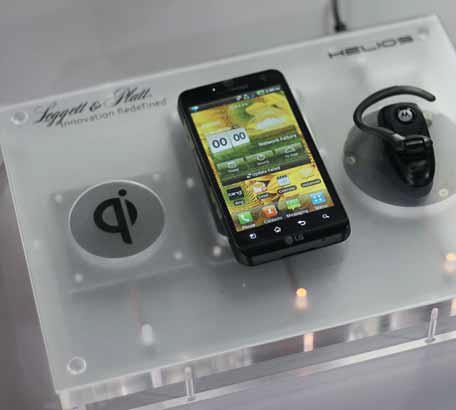Wireless power around the home
A new technology based on inductive coupling allows for safe and efficient power transfer without the need for cabling. Callum Fitzpatrick reports.
Although wireless power is by no means a new development, Fulton Innovation has made it accessible and brought it into the home, through eCoupled, a technology which enables the powering of kitchen appliances and charging of devices around the home with no cabling needed whatsoever.
eCoupled can embed into a range of surfaces, from kitchen countertops, to armchairs and coffee tables. Through the use of two coils – one located in the surface and one integrated into the appliance, a shared electromagnetic fi eld is generated when the coils are in close proximity. From here, it wirelessly sends power to, or charges, the device.
ADVERTISEMENT
Fulton Innovation director of advanced technologies David Baarman says that as well as a convenient and tidy way of charging, the technology also provides a very effi cient way of distributing power.
“When we first started, we had to communicate that wireless power can be safe, efficient and very effective. That was diffi cult because we are essentially competing with the trusted power cord.
Most people think that the power cord is 100% efficient, but in reality it’s much less than that.”
eCoupled is able to optimise power transfers at high efficiencies (greater than 98% at 120V/1.4Kw) under varying special confi gurations and load conditions – from low-power to highpower applications.
Additionally, its operation can be adapted to match the needs of the device it powers by communicating with it in real time – power is only supplied to devices that are in close proximity and are recognised as being compatible, to maintain a safe environment.
The whole principle behind the technology revolves around nearfield resonant magnetic induction. Traditionally, electronics use a power cord to transport power to the electronic circuits, and from there a transformer uses magnetic induction to form an inductive link to transfer power between the internal circuits. eCoupled simply replaces the conductive power cord with another inductive link.
“There is a whole supply chain of manufacturers that create the components and there are only a couple of components required; a tiny circuitboard, coil and a chipset.
“The circuitboard with this chip gets put into the back panel of your phone, tablet or computer and when it comes in proximity to a charging service, it receives that power, tells the transmitter what it needs and then it gets delivered exactly what it is requesting.
”Fulton was one of the founding members of the Wireless Power Consortium (WPC) and it is through this organisation that the ‘Qi’ (pronounced ‘chee’) Standard was introduced, allowing companies to bring out wireless chargers that work with a range of devices. RESEARCH AND DEVELOPMENT Power with no wires eCoupled technology replaces conductive power cords with an inductive link. eCoupled is placed in or under a bench or countertop.
“The Standard allows for the convergence of wireless power technology in general; it is a protocol for devices to be able to function together regardless of the specific technology that they have chosen to use,” David says.
When it comes to opportunities for the custom installer, David says it is through the Helios range of wireless charger ‘pucks’ that installers will be able to offer their clients a truly unique power solution.
“You can drill a hole into a countertop, drop this puck into it and then it can charge any ‘Qi’ certified device.”
By placing a device on the counter, or in close proximity, intelligent charging then delivers the required amount of power by communicating to the device and stops it charging when the charging cycle has been completed.
“You can create a Qi surface in a conference table, coffee table, an armchair – anywhere you want to have wireless charging,” David says.
“There is also a new version of this which can bolt underneath a surface so you don’t have to drill any holes; you just place it under a countertop and a ‘beep’ lets you know your device is charging.”
Looking to the future, David says that the technology will expand into new areas of the home, specifically the kitchen.
“We’re not just looking to charge your phone, we will also mount your whole cook surface underneath the granite countertop, so it never sees water, you never have to clean it and it’s completely protected. There’s no buttons, no knobs and no places to catch food, you can just set your pots and pans on a trivet and cook from there. You can also place your blender on there and power it, without any wires.
“We want to experiment with how connected our lives are becoming. In the past, you’d have to pay a premium dollar for an appliance that had more controls in it. But now, we constantly have smart phones with us, so it makes sense for us to control our devices with a smart phone.”
David says that when it comes to cooking, the recipe will eventually be able to dictate the cooking procedures.
“Instead of having to build all these extra electronics into a blender or into a frying pan, you will be able to select what temperature you want and you can tell it to boil and simmer, or cook for 30 minutes. The recipe can actually inform the electronics directly. It gives us a lot of capabilities also to use electricity in a smarter way by having sequences of events that are planned, in an orchestrated way, saving you power and balancing your load demand.”
-
ADVERTISEMENT
-
ADVERTISEMENT
-
ADVERTISEMENT
-
ADVERTISEMENT

